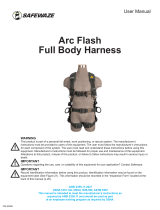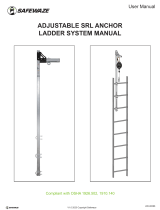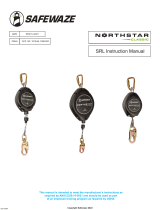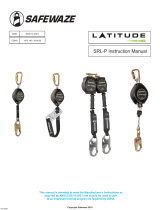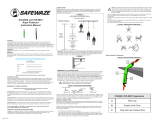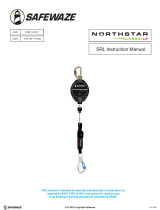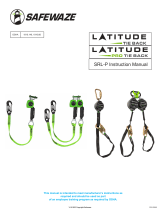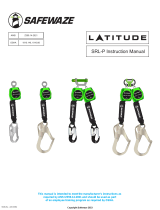Page is loading ...

ANSI Z359.11-2021
OSHA 1910.66, OSHA 1926.502
This manual is intended to meet the manufacturer’s instructions as
required by ANSI Z359.11 and should be used as part
of an employee training program as required by OSHA.
WARNING
This product is part of a personal fall arrest, work positioning, or rescue system. The manufacturer’s
instructions must be provided to users of this equipment. The user must follow the manufacturer’s instructions
for each component of the system. The user must read and understand these instructions before using this
equipment. Manufacturer’s instructions must be followed for proper use and maintenance of this equipment.
Alterations to this product, misuse of this product, or failure to follow instructions may result in serious injury or
death.
IMPORTANT
Questions regarding the use, care, or suitability of this equipment for your application? Contact Safewaze.
IMPORTANT
Record identication information before using this product. Identication information may be found on the
equipment label (See Figure 10). This information should be recorded in the “Inspection Form” located at the
back of this manual (p 14).
220-00029
D-ring Extender
Manual
Part
Number
Descrip�on ANSI Standard OSHA Regula�on Weight Capacity
019-2008 18" D-ring Extender: So� Loop, 2 D-rings Z359.11-2021
1926.502
1910.140
ANSI 130-310 lbs., OSHA up to 420 lbs.
019-2022 12" D-Ring Extender w/ So� Loop Z359.11-2021
1926.502
1910.140
ANSI 130-310 lbs., OSHA up to 420 lbs.
020-2051 18" D-Ring Extender, Orange Z359.11-2021
1926.502
1910.140
ANSI 130-310 lbs., OSHA up to 420 lbs.
020-2052 18" Dual D-Ring Extender, D-RING & 2 Snap Hooks Z359.11-2021
1926.502
1910.140
ANSI 130-310 lbs., OSHA up to 420 lbs.
020-2053 18" D-Ring Extender, Loop, Aluminum D-ring Z359.11-2021
1926.502
1910.140
ANSI 130-310 lbs., OSHA up to 420 lbs.
021-2074 18" D-ring Extender: Alu Rebar Hook, D-ring Z359.11-2021
1926.502
1910.140
ANSI 130-310 lbs., OSHA up to 420 lbs.
022-2080 12" Arc Flash D-Ring Extender w/ So� Loop Z359.11-2021
1926.502
1910.140
ANSI 130-310 lbs., OSHA up to 420 lbs.
022-2081 18" Arc Flash D-Ring Extender: So� Loop, D-ring Z359.11-2021
1926.502
1910.140
ANSI 130-310 lbs., OSHA up to 420 lbs.
FS813 18" D-Ring Extender: Snap Hook, D-ring Z359.11-2021
1926.502
1910.140
ANSI 130-310 lbs., OSHA up to 420 lbs.
FS813-24 24" D-Ring Extender, Snap Hook Z359.11-2021
1926.502
1910.140
ANSI 130-310 lbs., OSHA up to 420 lbs.
FS813-2D 18" D-Ring Extender: Snap Hook, 2 D-rings Z359.11-2021
1926.502
1910.140
ANSI 130-310 lbs., OSHA up to 420 lbs.
FS813-LOOP 18" D-Ring Extender: So� Loop, D-ring Z359.11-2021
1926.502
1910.140
ANSI 130-310 lbs., OSHA up to 420 lbs.
FS814 18" D-ring Extender: Rebar Hook, D-ring Z359.11-2021
1926.502
1910.140
ANSI 130-310 lbs., OSHA up to 420 lbs.

V1.0 2022 Copyright Safewaze
ANSI Z359.11-2021
OSHA 1910.66, OSHA 1926.502
This manual is intended to meet the manufacturer’s instructions as
required by ANSI Z359.11 and should be used as part
of an employee training program as required by OSHA.
User Information
Date of First Use:______________________________
Serial#:____________________________________
Trainer:____________________________________
User:______________________________________
Table of Contents
1.0 INTRODUCTION ............... ...............................................5
2.0 APPLICATION ...................................................................5
3.0 APPLICABLE SAFETY STANDARDS ...............................5
4.0 WORKER CLASSIFICATIONS ..........................................5
5.0 PURPOSE .........................................................................5
6.0 LIMITATIONS & REQUIREMENTS ................................6-7
7.0 COMPATIBILITY OF COMPONENTS ...............................8
8.0 COMPATIBILITY OF CONNECTORS ...............................8
9.0 MAKING CONNECTIONS ..............................................8-9
10.0 APPLICATION LIMITS ......................................................9
11.0 RESTRICTIONS ........................................................... 9-10
12.0 PRE-USE INSPECTION ..................................................10
13.0 USE .................................................................................10
14.0 MAINTENANCE, CLEANING & STORAGE ................10-11
15.0 INSPECTION ...............................................................11-12
16.0 LABELING .......................................................................13
17.0 INSPECTION FORM .......................................................14

This product is part of a complete fall protection system. A PFAS is typically composed of a Full Body Harness,
Anchorage, and a Connecting Device. Connecting Devices used with Safewaze Full Body Harnesses are Energy
Absorbing Lanyards (EAL’s) or a Self Retracting Lifeline (SRL). The connection point to the FBH for use of a Vertical
Lifeline (VLL) is the Sternal (Front) D-ring.
These instructions must be provided to any person utilizing this equipment. The worker must read and understand the
manufacturer’s instructions for this, and all other components of the complete Fall Protection System. It is expected
that all personnel be fully trained in the safe installation and use of this equipment. These instructions must be followed
for the proper use, maintenance, and inspection of this equipment. These instructions must be kept and made available
to worker’s at all times. Any alteration, misuse, or use of this equipment outside the scope of the manufacturer’s
instructions, may result in serious injury or death. A comprehensive Fall Protection Plan must be kept on le and
available to all employees at all times.
D-Ring Extenders are connected to the Dorsal D-ring of a Full Body Harness (FBH). The D-ring Extender provides
additional spacing between the user’s Dorsal D-ring and their fall protection device. When attached to the Dorsal D-ring
of a FBH, the D-ring Extender becomes a component of the FBH as part of the complete Personal Fall Protection System
(PFAS).
NEVER attach addtional equipment to the Dorsal D-ring of a Full Body Harness while a D-ring extender remains
connected. The D-ring extender must be removed from the Dorsal D-ring prior to connection of a separate piece of
fall protection equipment. Two active connections to a single D-ring does not comply with ANSI or OSHA regulations.
Working at heights involves inherent risks. Leading Edge environments add additional risks to any Fall Protection or
Rescue Plan. If work involves a Leading Edge environment, the use of a D-ring Extender IS NOT authorized. D-ring
extenders can interfere with the proper function and performance of a Leading Edge Rated SRL or Energy Absorbing
Lanyard. Use of a Safewaze D-ring Extender in any Leading Edge application may result in serious injury or death!
Consult your doctor if there is reason to doubt your tness to safely absorb the shock from a fall arrest. Age and tness
seriously aect a worker’s ability to withstand falls. Pregnant women or minors must not use this equipment. Failure to
heed this warning may result in serious injury or death.
Never exceed the maximum allowable capacity of your fall protection equipment. Never exceed the maximum free fall
distance of your fall protection equipment.
Do not use this system or any other part of a PFAS that fails pre-use or other scheduled inspections. For any questions
or concerns regarding the use of this equipment for an application not specied in this manual, contact Safewaze
technical support.
Additional precautions should be used when working in environments of high heat, electrical hazards, chemical hazards,
explosive or combustible chemicals, toxic materials, or sharp edges. Ensure that equipment in use on the next higher
level cannot fall and possibly strike a user below, or make contact with a piece of the user’s PFAS
Contact Safewaze if you have questions regarding compatibility of this equipment that are not covered in this manual.
Do not alter or misuse this equipment. Some subsystem components could aect the performance and the operation of
this equipment. Do not anchor this product to moving machinery, or hazards that have chemical, electrical or gaseous
characteristics. Failure to comply with this warning could result in serious injury or death.
Use of a body belt for fall protection applications is not permitted. Only use an approved Full Body Harness.
Inspect all components of this system prior to each use and at least annually. Inspect in accordance with the user
instructions. If this equipment is exposed to the forces of a Fall Arrest or Impact Force, the equipment must be removed
from service and inspected by a Competent Person prior to being used again.
Personnel must always maintain 3 points of contact during climbing operations. If utilizing components from dierent
manufacturers, ensure that all components are compatible and meet all applicable standards, codes, and requirements.
Before using this equipment, consult with a Competent and/or Qualied Person.
Make considerations for eliminating or minimizing all swing fall hazards. Swing falls occur when the anchor is not
directly above the location where a fall occurs. Always work as close to in line with the anchor point as possible.
Swing falls signicantly increase the likelihood of serious injury or death in the event of a fall.
Do not throw away these instructions!
Read and understand these instructions before using equipment!
WARNING
1

V1.0 2022 Copyright Safewaze
IMPORTANT
Per ANSI Z359.11-2021:
The following is additional information concerning the location and use of various attachments that may be provided on
a FBH:
It is essential that the users of this type of equipment receive proper training and instruction including detailed procedures for the
safe use of such equipment in their work application. ANSI/ASSP Z359.2, Minimum Requirements for a Comprehensive Managed
Fall Protection Program, establishes guidelines and requirements for an employer’s managed fall protection program including
policies, duties and training; fall protection procedures; eliminating and controlling fall hazards; rescue procedures; incident
investigations; and evaluating program eectiveness.
Suspension intolerance, also called suspension trauma or orthostatic intolerance, is a serious condition that can be controlled with
good harness design, prompt rescue and post fall suspension relief devices. A conscious user may deploy a suspension relief
device allowing the user to remove tension from around the legs, freeing blood ow, which can delay the onset of suspension
intolerance. An attachment element extender is not intended to be attached directly to an anchorage or anchorage connector for
fall arrest. An energy absorber must be used to limit maximum arrest forces to 1800 pounds (8 kN). The length of the attachment
element extender may aect free fall distances and free fall clearance calculations.
Dorsal - The dorsal attachment element shall be used as the primary fall arrest attachment unless the application allows the use
of an alternate attachment. The dorsal attachment may also be used for travel restraint or rescue. When supported by the dorsal
attachment during a fall, the design of the FBH shall direct load through the shoulder straps supporting the user and around the
thighs. Supporting the user, post fall, by the dorsal attachment will result in an upright body position with a slight lean to the front
with some slight pressure to the lower chest. Considerations should be made when choosing a sliding versus xed dorsal
attachment element. Sliding dorsal attachments are generally easier to adjust to user sizes, and allow a more vertical rest
position post fall, but can increase FBH stretch.
When not in use, unused lanyard legs that are still attached to a FBH D-ring should not be attached to a work positioning element
or any other structural element on the FBH unless deemed acceptable by the competent person and manufacturer of the lanyard.
This is especially important when using some types of “Y” style lanyards, as some load may be transmitted to the user through the
unused lanyard leg if it is not able to release from the harness. The lanyard parking attachment is generally located in the sternal
area to help reduce tripping and entanglement hazards.
Loose ends of straps can get caught in machinery or cause accidental disengagement of an adjuster. All FBHs shall include
keepers or other components which serve to control the loose ends of straps.
Due to the nature of soft loop connections, it is recommended that soft loop attachments only be used to connect with other soft
loops or carabiners. Snaphooks should not be used unless approved for the application by the manufacturer.
Users must follow manufacturer’s instructions for proper t and sizing, paying particular attention to ensure that buckles are
connected and aligned correctly, leg straps and shoulder straps are kept snug at all times, chest straps are located in the middle
chest area and leg straps are positioned and snug to avoid contact with the genitalia should a fall occur.
FBH stretch / D-ring Extender Length. The amount the FBH component of a personal fall arrest system will stretch and deform
during a fall, can contribute to the overall elongation of the system in stopping a fall. It is important to include the increase in fall
distance created by FBH stretch, as well as the FBH connector length, the settling of the user’s body in the FBH and all other
contributing factors when calculating total clearance required for a particular fall arrest system. The length of the D-ring Extender
must also be factored into overall fall clearance calculations.
Sternal - The sternal attachment may be used as an alternative fall arrest attachment in applications where the dorsal
attachment is determined to be inappropriate by a competent person and where there is no chance to fall in a direction other
than feet rst. Accepted practical uses for sternal attachment include, but are not limited to, ladder climbing with a guided type
fall arrester, ladder climbing with an overhead self-retracting lifeline for fall arrest, work positioning and rope access. The sternal
attachment may also be used for travel restraint or rescue. When supported by the sternal attachment during a fall, the design of
the FBH shall direct load through the shoulder straps supporting the user and around the thighs. Supporting the user, post fall,
by the sternal attachment will result in roughly a sitting or cradled body position with weight concentrated on the thighs, buttocks,
and lower back. Supporting the user during work positioning by this sternal attachment will result in an approximate upright
body position.
FBHs which meet ANSI/ASSP Z359.11 are intended to be used with other components of a personal fall arrest system that limit
maximum arrest forces to 1800 pounds (8kN) or less.
Correct t of a Full Body Harness (FBH) is essential to proper performance. Users must be trained to select the size and maintain
t of the FBH selected for use with the Safewaze D-ring Extender.
2

V1.0 2022 Copyright Safewaze
D- Frontal Attachment E- Hip Attachment F- Waist, Rear Attachment
A- Dorsal Attachment B- Sternal Attachment C- Shoulder Attachment
If the sternal attachment is used for fall arrest, the competent person evaluating the application should take measures to ensure
that a fall can occur feet rst. This may include limiting the allowable free fall distance. It may be possible for a sternal attachment
incorporated into an adjustable style chest strap to cause the chest strap to slide up and possibly choke the user during a fall,
extraction, suspension, etc. The competent person should consider FBH models with a xed sternal attachment for these
applications.
Frontal - The frontal attachment serves as a ladder climbing connection for guided type fall arresters where there is no chance to
fall in a direction other than feet rst or may be used for work positioning. Supporting the user, post fall or during work positioning,
by the frontal attachment will result in a sitting body position with the upper torso upright with weight concentrated on the thighs
and buttocks. When supported by the frontal attachment the design of the FBH shall direct load directly around the thighs and
under the buttocks by means of the sub-pelvic strap.
If the frontal attachment is used for fall arrest, the competent person evaluating the application should take measures to ensure
that a fall can only occur feet rst. This may include limiting the allowable free fall distance.
Shoulder - The shoulder attachment elements shall be used as a pair and are an acceptable attachment for rescue and entry/
retrieval. The shoulder attachment elements shall not be used for fall arrest. It is recommended that the shoulder attachment
elements be used in conjunction with a yoke which incorporates a spreader element to keep the FBH shoulder straps separate.
Waist, Rear - The waist, rear attachment shall be used solely for travel restraint. The waist, rear attachment element shall not
be used for fall arrest. Under no circumstances is it acceptable to use the waist, rear attachment for purposes other than travel
restraint. The waist, rear attachment shall only be subjected to minimal loading through the waist of the user and shall never be
used to support the full weight of the user.
Hip - The hip attachment elements shall be used as a pair and shall be used solely for work positioning. The hip attachment
elements shall not be used for fall arrest. Hip attachments are often used for work positioning by arborists, utility workers
climbing poles and construction workers tying rebar and climbing on form walls. Users are cautioned against using the hip
attachment elements (or any other rigid point on the FBH) to store the unused end of a fall arrest lanyard as this may cause a
tripping hazard or, in the case of multiple leg lanyards, could cause adverse loading to the FBH and the wearer through the
unused portion of the lanyard.
Suspension Seat - The suspension seat attachment elements shall be used as a pair and shall be used solely for work
positioning. The suspension seat attachment elements shall not be used for fall arrest. Suspension seat attachments are often
used for prolonged work activities where the user is suspended allowing the user to sit on the suspension seat formed between
the two attachment elements. An example of this use would be window washers on large buildings.
FIGURE 1 - APPROVED D-RING APPLICATIONS
Fall Arrest Dorsal, Sternal, Frontal
Restraint Dorsal, Sternal, Frontal, Hip, Rear
Work Positioning Frontal, Hip
Rescue Dorsal, Sternal, Frontal, Shoulder
Controlled Descent Dorsal, Sternal, Frontal
Climbing Dorsal, Sternal
Harness Attachment LocationApplication
32

V1.0 2022 Copyright Safewaze
USER INSPECTION, MAINTENANCE AND STORAGE OF EQUIPMENT
MAINTENANCE AND STORAGE
Users of personal fall arrest systems shall at a minimum, comply with all manufacturer instructions regarding the inspection,
maintenance and storage of the equipment. The user’s organization shall retain the manufacturer’s instructions and make them
readily available to all users. See ANSI Z359.2, Minimum Requirements for a Comprehensive Managed Fall Protection Program,
regarding user inspection, maintenance and storage of equipment.
1. In addition to the inspection requirements set forth in the manufacturer’s instructions, the equipment shall be inspected
by the user before each use and additionally by a competent person, other than the user, at interval of no more than
one year for:
• Absence or illegibility of markings.
• Absence of any elements aecting the equipment form, t or function.
• Evidence of defects in, or damage to, hardware elements including cracks, sharp edges, deformation, corrosion, chemical
attack, excessive soiling, abrasion, alteration, needed or excessive lubrication, excessive aging and excessive wear.
2. Inspection criteria for the equipment shall be set by the user’s organization. Such criteria for the equipment shall equal
or exceed the criteria established by this standard or the manufacturer’s instructions, whichever is greater.
1. Maintenance and storage of equipment shall be conducted by the user’s organization in accordance with the
manufacturer’s instructions. Unique issues, which may arise due to conditions of use, shall be addressed with the
manufacturer.
3. Equipment shall be stored in a manner as to preclude damage from environmental factors such as temperature, light,
UV, excessive moisture, oil, chemicals and their vapors or other degrading elements.
2. Equipment which is in need of, or scheduled for, maintenance shall be tagged as unusable and removed from service.
3. When inspection reveals defects in, damage to, or inadequate maintenance of equipment, the equipment shall be
permanently removed from service or undergo adequate corrective maintenance by the original equipment
manufacturer or their designate before return to service.
43

V1.0 2022 Copyright Safewaze
1.0 INTRODUCTION
Thank you for purchasing a Safewaze D-ring Extender. This manual must be read and understood in its entirety, and used as part
of an employee training program as required by OSHA or any applicable state agency. This manual and any other instructional
material must be available to the user of the equipment. The user must understand how to safely and eectively use their D-ring
Extender, and all fall protection equipment used in conjunction with the extender.
The Safewaze D-ring Extender is a bodywear component of the user’s Personal Fall Arrest System (PFAS). Safewaze D-ring
Extenders are oered in a variety of congurations to ensure that the user can work safely and comfortably in any work
environment. These instructions will cover the proper installation and use of an extender. The extender is part of a complete
PFAS that requires a properly rated anchorage and connector, that in conjunction with an appropriate connecting device, meets
the fall protection requirement.
2.0 APPLICATION
3.0 APPLICABLE SAFETY STANDARDS
When used according to instructions, extenders included in this manual meet ANSI Z359.11-2021 and OSHA regulations for
fall protection. Applicable standards and regulations depend on the type of work being done, and may include state-specic
regulations. Refer to local, state, and federal (OSHA) requirements for additional information concerning the governing of
occupational safety regarding Personal Fall Arrest Systems (PFAS).
4.0 WORKER CLASSIFICATIONS
Understand the denitions of those who work in proximity of or may be
exposed to fall hazards.
Qualied Person: “Qualied Person” means one who, by possession of a recognized degree, certicate, or professional
standing, or who by extensive knowledge, training, and experience, has successfully demonstrated his ability to solve or resolve
problems relating to the subject matter, the work, or the project.
Competent Person: “Competent Person” means one who is capable of identifying existing and predictable hazards in the
surroundings or working conditions which are unsanitary, hazardous, or dangerous to employees, and who has authorization to
take prompt corrective measures to eliminate them.
Authorized Person: “Authorized Person” means a person approved or assigned by the employer to perform a specic type of
duty or duties or to be at a specic location or locations at the job site.
It is the responsibility of a Qualied or Competent person to supervise the job site and ensure safety
regulations are complied with.
5.0 PURPOSE
Purpose: The Safewaze series of D-ring Extenders are designed to be used as part of a Personal Fall Arrest System (PFAS).
- A competent person shall train users on this equipment in accordance with OSHA and ANSI.
- Never exceed a free fall distance of 6 ft. A free fall of more than 6 ft could cause excessive arrest forces that
could result in serious injury or death.
- Safewaze D-ring Extenders have a maximum capacity of:
ANSI 310 lbs (140.6 kg) including tools, clothing, etc..., OSHA up to 420 lbs. (190.51 kg) including tools,
clothing, etc...
- Anchorages for attachment of a Personal Fall Arrest System shall support a minimum of 5,000 lbs or be
designed with a safety factor of two by a Qualied Person.
- All Safewaze D-ring Extenders must IMMEDIATELY be removed from service if subjected to fall
arrest forces.
- Safewaze D-ring Extenders shall be inspected by the end user prior to each usage and by a Competent
Person other than the user at least annually. These annual inspections shall be documented.
5
4

V1.0 2022 Copyright Safewaze
From OSHA 1926.502 and 1910.66
Anchorages used for attachment of personal fall arrest systems shall be independent of any anchorage being used to support or
suspend platforms, and capable of supporting at least 5,000 lbs (22.2 kN) per user attached, or be designed, installed, and used
as part of a complete personal fall arrest systems which maintains a safety factor of at least two, and is under the supervision of a
qualied person.
When using this equipment, employers must create a rescue plan, and provide the means to implement the plan. This plan must
be communicated to equipment users, authorized persons, and rescuers. Rescue operations require specialized equipment
beyond the scope of this manual. See ANSI Z359.4-2013 for specic rescue information.
Safewaze D-ring Extenders are designed for the following weight capacities
(Maximum capacities include clothing, tools, and equipment):
ANSI Z359: 130-310 lbs max
OSHA: Up to 420 lbs max
6.3 INSPECTION FREQUENCY
6.4 RESCUE PLAN
6.0 LIMITATIONS & REQUIREMENTS
6.1 CAPACITY
When installing or using this equipment always refer to the following requirements and limitations:
6.2 ANCHORAGE
Anchorages selected for fall arrest systems shall have a strength capable of sustaining static loads applied in the directions
permitted by the system of at least:
1. 5,000 lbs. (22.2 kN) for non-certied anchorages, or
2. Two times the maximum arresting force for certied anchorages.
When more than one fall arrest system is attached to an anchorage, the strengths set forth in (1) and (2) above shall be multiplied
by the number of systems attached to the anchorage.
NOTE: Special rescue measures may be required for a fall over an edge.
In order to ensure reduced fall distances, always attempt to anchor the connecting device directly overhead. Overhead anchoring
will limit free fall distance to a minimum. Be aware of workers sharing the workspace to avoid becoming tangled with another
worker. Steer clear of objects that could fall and impact a lifeline. The lifeline should never pass under the user’s arms or legs. A
lifeline should never be knotted, clamped, or be otherwise modied.
A Personal Fall Arrest System (PFAS) must utilize a Full Body Harness. Refer to Figure 1 of this manual for specic FBH D-ring
approved applications.
It is important to make sure that adequate clearance is available. Free Fall, Maximum Arrest Distance, Height of Worker, and
current clearance above the next fall hazard must all be considered in the Fall Clearance calculation.
6.5 FREE FALL
6.6 BODY SUPPORT
6.7 FALL CLEARANCE
6.8 DETERMINE MINIMUM REQUIRED FALL CLEARANCE
Either the Authorized Person (User), or the Rescuer must inspect this equipment before each use. Annual inspections must be
completed by a Competent Person other than the user. Results must be documented.
6

V1.0 2022 Copyright Safewaze
Fall Clearance: There must be sucient clearance below the anchorage connector to arrest a fall before the user strikes the
ground or an obstruction. When calculating fall clearance, account for a MINIMUM 2’ safety factor, deceleration distance, user
height, length of lanyard/SRL, and all other applicable factors. Figure 2 illustrates an “example” of a typical fall clearance
calculation.
7
LOAD INDICATOR
L
OAD IN
D
ICATOR
A
FALL-ARREST
LOAD INDICATOR
L
O
A
D
IN
D
IC
ATO
R
A
FALL-ARREST
L
O
A
D
I
ND
I
C
AT
OR
LO
AD
I
ND
I
C
A
T
O
R
A
FALL-ARREST
L
O
A
D
I
ND
I
C
AT
OR
LO
AD
I
ND
I
C
A
T
O
R
A
FALL-ARREST
B
A
D
D
C
E
“D” represents distance from the user’s Dorsal
D-ring to the walking/working surface prior
to any type of fall event. Actual distance can
vary based on user’s height.
***Diagram shown is an EXAMPLE fall clearance calculation.
Actual fall clearance calculations are dependent upon the Energy Absorbing Lanyard (EAL) or Self-Retracting Lifeline (SRL) used as part of the complete Personal Fall Arrest System (PFAS).
A 6 ft Length of Shock Absorbing Lanyard
(Original working length)
B 4 ft
Elongation / Deceleration Distance
(Maximum Allowed Deployment of Energy Absorber)
C 1-1/2 ft Length of D-ring Extender
D 5 ft Dorsal D-ring Height
E 2 ft
Safety Factor
(Includes allowance for FBH Stretch/Dorsal D-ring Shift)
F 18-1/2 ft
Total
(Minimum Required Fall Clearance)
Fall Clearance Diagram
For all applications: worker weight capacity range
(including all clothing, tools, and equipment) is
ANSI 130-310 lbs., OSHA 420 lbs.
FIGURE 2
6.9 SWING FALLS
An anchorage point located in a position that is not directly over the user’s fall location results in a swing fall (See Figure 3). Swing
falls may result in the user striking an object with enough force to cause serious injury. Greater clearance is needed to ensure
safety during a swing fall as vertical fall distance will be greater than a fall originating directly below the anchorage point.
FIGURE 3 - SWING FALLS
A
FALL-ARREST
S
W
I
N
G
F
A
L
L

V1.0 2022 Copyright Safewaze
Unless otherwise noted, Safewaze equipment is designed for use with Safewaze approved components and subsystems only.
Substitutions or replacements made with non approved components or subsystems may jeopardize compatibility of equipment
and may aect safety and reliability of the complete system.
Read and follow manufacturer’s instructions for associated components and subsystems in your
personal fall arrest system.
Connectors are compatible with connecting elements when they have been designed to work together in such a way that their
sizes and shapes do not cause their gate mechanisms to inadvertently open regardless of how they become oriented. Connectors
(hooks, carabiners, and D-rings) must be capable of supporting at least 5,000 lbs. (22.2 kN). Do not use equipment that is not
compatible. Non-compatible connectors may unintentionally disengage (See Figure 4). Connectors must be compatible with the
anchorage or other system components (See Figure 5). Connectors must be compatible in size, shape, and strength. Self-locking
snap hooks and carabiners are required by ANSI Z359 and OSHA guidelines. Contact Safewaze if you have any questions about
compatibility.
NOTE: SOME SPECIALTY CONNECTORS HAVE ADDITIONAL REQUIREMENTS. CONTACT
SAFEWAZE WITH QUESTIONS.
FIGURE 4 - UNINTENTIONAL DISENGAGEMENT
3 - gate opens
2 - gate presses
against
non-complaint part
4 - parts disengage
1 - Non-compliant part
Using a connector that is undersized or irregular in shape (1) to connect a snap hook or carabiner could allow the connector to
force open the gate of the snap hook or carabiner. When force is applied, the gate of the hook or carabiner presses against the
non-compliant part (2) and forces open the gate (3). This allows the snap hook or carabiner to disengage (4) from the connection
point.
7.0 COMPATIBILITY OF COMPONENTS
8.0 COMPATIBILITY OF CONNECTORS
Snap hooks and carabiners used with this equipment must be double locking and/or twist lock. Ensure all connections are
compatible in size, shape and strength. Do not use equipment that is not compatible. Ensure all connectors are fully closed and
locked.
Safewaze connectors (snap hooks and carabiners) are designed to be used only as specied in each product’s user instructions.
See Figure 5 for examples of inappropriate connections. Do not connect snap hooks and carabiners:
• To a D-ring to which another connector is attached.
• In a manner that would result in a load on the gate (with the exception of tie-back hooks). NOTE: Large snap hooks must not
be connected to objects which will result in a load on the gate if the hook twists or rotates, unless the snap hook complies with
ANSI Z359.12 and is equipped with a 3,600 lb (16 kN) gate. Check the marking on your snap hook to verify its compatibility.
9.0 MAKING CONNECTIONS
FIGURE 5 - INAPPROPRIATE CONNECTIONS
8
IMPORTANT:

V1.0 2022 Copyright Safewaze
FIGURE 7 - CONNECTION TO FBH
FIGURE 6 - TYPICAL CONNECTION AS PART OF A COMPLETE PFAS
9
Precautions should be taken in the design and installation of a PFAS in order to avoid hazards such as thermal, chemical, or
electrical hazards. Avoid moving machinery, sharp and/or abrasive edges, and any other hazard that could damage or degrade
components of the PFAS.
Safewaze D-ring Extrenders are oered in a variety of congurations to suit a multitude of work environments. The unique
features of a specic extender may not be suited for all applications. The following are some restrictions that should be
considered prior to use of your Safewaze D-ring Extender:
Extended Free Falls: All Safewaze D-ring Extenders are designed and rated for 6’ (1.83 m) and 12’ (3.66 m) FF
applications. For 12’ FF applications, the user must use a Personal Energy Absorber (PEA) rated for for this level of
free fall.
Harsh Chemical Environments: Work operations in a caustic or acidic chemical hazard environment may cause
damage to your Safewaze D-ring Extender. Damage to the extender due to chemical exposure can, in some instances,
be dicult to detect. In any environment, the extender must be inspected prior to each use, however, a harsh
chemical environment can necessitate more frequent inspections. Care should be taken to inspect the extender before,
during, and after each use. A harsh chemical environment may also cause a need for more frequent replacement of the
extender.
Welding, Arc Flash, High Heat Environments: If work operations are conducted in an environment where the D-ring
Extender may be exposed to extremely high temperatures, the user should choose an extender specically designed for
these environments. Specic extenders are available for welding, re resistance, and ARC Flash environments.
Heavyweight: Although ANSI Z359.11 species a weight capacity range of 130 to 310 lbs. (59 to 140 kg), most
Safewaze D-ring Extenders have a maximum weight capacity of up to 420 lbs. (191 kg). If the user has a weight that
exceeds the ANSI max weight of 310 lbs. (140 kg), it should be ensured that other components of the PFAS are rated
for a heavyweight user.
10.0 APPLICATION LIMITS
11.0 RESTRICTIONS
LOAD INDICATOR
LO
AD
I
N
D
ICAT
OR
A
FALL-ARREST
LOA
D
I
N
D
IC
AT
O
R
LOAD INDICATOR
A
FALL-ARREST
ANSI Z359.14, ANSI A10.32
OSHA 1910.66, OSHA 1926.502
0
2
0
0
5
1
LOA
D
I
N
D
IC
AT
O
R
LOAD
IND
I
C
A
TOR
A
FALL-ARREST
X
LOA
D
I
N
D
IC
AT
O
R
LO
AD
I
N
DICAT
OR
A
FALL-ARREST

V1.0 2022 Copyright Safewaze
Upon receiving your Safewaze D-ring Extender, remove the product from the packaging and fully inspect extender for possible
damage that may have occurred during shipping.
Prior to each use, inspect for the following conditions:
- Inspect the webbing of the extender for cuts, frays, broken stitching, damage from heat or chemical exposure, or other
defects related to excessive wear or abrasion.
- Inspect the extender for indications that it has been exposed to fall arrest forces.
- Inspect extender labeling to ensure that they are legible and present on the harness. If any labeling is illegible,
or missing, remove the extender from service.
12.0 PRE-USE INSPECTION
10
13.0 INSTALLATION AND USE
Should the Safewaze D-ring Extender be exposed to an the force of a fall, or shows damage consistent with the eects of a fall, it
must be IMMEDIATELY removed from service. Equipment must then be disposed of (See Section 15.5).
13.2 AFTER A FALL
Inspect the extender, as described in Section 15 prior to use. Refer to Figure 6 for the most common extender connections.
Ensure connections are compatible in size, shape, and strength. Ensure hooks are fully closed and locked.
13.1 OPERATION
Figure 6 illustrates typical D-ring Extender connections when working at heights. When using a snap hook to make a connection,
ensure roll-out cannot occur (See Figure 4). Do not use snap hooks or carabiners that will not completely close over the anchor
point. This includes traditional overhead anchor point tie o, SRL housing attachment to dorsal D-ring, and 100% tie o. Follow the
manufacturer’s instructions supplied with each system component. Figure 7 indicates examples of inappropriate and appropriate
connection to the Dorsal D-ring of a Full Body Harness, as well as the appropriate installation of a Soft Loop D-ring Extender.
13.3 HARNESS CONNECTIONS
Remove the Safewaze D-ring Extender from use if the extender has been subjected to fall arrest forces or inspection reveals an
unsafe or defective condition. If unsafe or defective condition is found, dispose of the extender as recommended in section 15.5.
14.0 MAINTENANCE, CLEANING, & STORAGE
14.1 MAINTENANCE
The components of a PFAS used in conjunction with the Safewaze D-ring Extender
should meet the requirements of the ANSI Z359 Fall Protection Code.
WARNING:
IMPORTANT:
Contact Safewaze if you have questions, regarding compatibility of this equipment. Do not alter or
misuse this equipment. Some subsystem components could aect the performance and the operation
of this equipment. Do not connect this product to moving machinery, or hazards that include chemical,
electrical or gaseous characteristics. Failure to comply with this warning could result in serious injury or
death.
Installation of any Safewaze D-ring Extender must be performed under the supervision of a Competent Person trained in their use
and design.
Ensure selected anchor location meets the strength requirements as indicated in Section 6 of this manual.
Do not allow free-fall to exceed 6 ft.
Any equipment exposed to Fall Arrest forces must be removed from service immediately.
See section 13.3 for specic installation details.

V1.0 2022 Copyright Safewaze 11
Cleaning procedures for Safewaze D-ring Extenders are as follows:
If webbing becomes soiled or requires cleaning, use water and a mild soap solution.
Clean labels to maintain legibility.
Hang the extender and allow to fully dry before using. Do not dry the extender in a commercial type dryer, or use heated air to dry.
14.2 CLEANING
Store Safewaze D-ring Extenders in a cool, dry, clean environment out of direct sunlight. Avoid areas where chemical vapors may
exist. Thoroughly inspect extender after any period of extended storage.
14.3 STORAGE
Inspect the webbing of the extender for cuts, frays, broken stitching, damage from heat or chemical exposure, or other defects
related to excessive wear or abrasion.
Inspect the D-ring Extender for indications that it has been exposed to fall arrest forces.
Inspect extender labeling to ensure that they are legible and present. If any labeling is illegible or missing, remove the extender
from service.
Inspect the D-ring Extender to include stitching and hardware. Ensure no stitches are broken, frayed, or cut. Inspect that
hardware functions properly and does not display any excessive corrosion. Inspect all extender webbing and stitching for
possible damage or defects.
Figure 8 shows examples of equipment damage. Equipment inspectors must be trained to look for damage to components of the
D-ring Extender as illustrated in Figure 8, as well as other damage that may occur. If inspection reveals an unsafe or defective
condition remove the extender from service.
In addition to inspection prior to each use, the extender must be inspected annually by a competent person other than the user.
Severe or harsh environments may require more frequent inspections.
Cut
Frayed Heavily Soiled
Welding Burns
15.0 INSPECTION
15.1 BEFORE EACH USE
15.2 INSPECTION FREQUENCY
15.3 UNSAFE OR DEFECTIVE CONDITIONS
FIGURE 8 - EXAMPLES OF EQUIPMENT DAMAGE

V1.0 2022 Copyright Safewaze
11 12
The working life of Safewaze D-ring Extenders are determined by work conditions, care and inspection provided. As long as the
extender passes inspection, it may remain in service.
Dispose of the Safewaze D-ring Extender if it has experienced fall arrest forces or inspection reveals an unsafe or defective
condition. Before disposing of the extender, cut into separate sections to prevent future use.
FIGURE 9 - INSPECTION DIAGRAMS
15.4 PRODUCT LIFE
15.5 DISPOSAL
WARNING:
WARNING:
Consult your doctor if there is reason to doubt your tness to safely absorb the shock from a fall arrest.
Age and tness seriously aect a worker’s ability to withstand falls. Pregnant women or minors must not
use Safewaze D-ring Extenders. Failure to heed this warning may result in serious injury or death.
DO NOT use the D-ring Extender to hoist tools or equipment.
Arc Flash
i
Web Loop
Rebar Hook
Snap Hook
Hardware
Webbing
Webbing
Webbing
Webbing
Wear Sleeve
Wear Sleeve
Stitching
Stitching
Stitching
Stitching
Hardware
Hardware
Hardware
Hardware

V1.0 2022 Copyright Safewaze 13
FIGURE 10 - LABEL EXAMPLES
16.0 LABELING

V1.0 2022 Copyright Safewaze
Label (Intact and Legible)
Appropriate ANSI / OSHA / CSA Markings
Inspections are Current / Up-to-Date
Date of First Use
Impact / Fall Indicators Not Deployed
Signs of Deformity of Damage
Proper D-ring attachment and operation
All Buckles Undamaged and Operational
Corrosion / Pitting / Nicks
Ensure Grommets are Secure / Do Not Move
Shoulder / Chest / Leg / Back Straps
Cuts / Burns / Holes
Paint Contamination
Excessive Wear
Heat / UV Damage
Shoulder / Chest / Leg / Back Straps
PASS
PASS
PASS
PASS
FAIL
FAIL
FAIL
FAIL
NOTE
NOTE
NOTE
NOTE
LABELS & MARKINGS
HARDWARE
(Buckles & D-Rings)
WEBBING
STITCHING
CONSTRUCTION HARNESS
FULL BODY HARNESS
INSPECTION FORM
HARNESSES
Model Number:
Name of Inspector:
Harness Conguration:
Serial Number:
Description:
Signature:
Lot Number:
Date of Inspection:
Date of Manufacture:
In-Service Date:
Company:
Manufacturer:
PT PT
Yes No
TB TB
Chest
Strap
Leg
Straps
Waist
Belt
NOTES
Shoulder
Straps
Adjustment
Buckles
Side
D-Rings
Waist Belt
Leg Straps
Labels
Dorsal
D-Ring
Back
Strap
Impact Indicators
Chest
Strap
LOAD INDICATOR
LOAD INDICATOR
STOP
REMOVE FROM
SERVICE
LOAD INDICATOR
LOAD INDICATOR
STOP
REMOVE FROM
SERVICE
225 Wilshire Avenue SW, Concord NC 28025 • 800-230-0319 • www.safewaze.com
13 14
Product lifetime is indenite as long as it passes pre-use and Competent Person inspections. User must inspect prior to each use.
Competent Person other than the user must complete formal inspection at least annually.
If equipment fails inspection
IMMEDIATELY REMOVE FROM SERVICE
17.0 INSPECTION FORM

V1.0 2022 Copyright Safewaze
Safewaze
225 Wilshire Ave SW
Concord, NC 28025
PHONE: 1-800-230-0319
FAX: 1-704-262-9051
WEB: Safewaze.com
EMAIL: [email protected]
/
